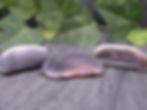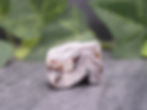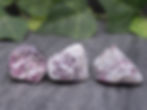
I was at a fellow rockhound's place who was selling me a bunch of his stuff. I spotted this very cool looking rock and asked him about it. He said he didnt know what it was or where it came from, but I decided to buy it off him. I'm quite certain this rock in question is a Rhyolite, which is a fine grained silica rich volcanic rock.

Amazonite's name comes from the Amazon River, where these stones were originally thought to be found. Amazonite has been used as jewelry for over 3000 years. It is found in many places throughout the world.

Amethyst gets it's name from a Greek word meaning "not intoxicated" as the Greeks believed Amethyst helped keep one sober. Most Amethyst comes from South America or Madagascar, but the Thunder Bay area in Ontario, Canada has a notable Amethyst deposit.

The name aventurine derives from the Italian "a ventura" meaning "by chance". Aventurine is a form of quartz, characterised by its translucency and the presence of platy mineral inclusions that give it a shimmering or glistening effect termed "aventurescence".

Blue lace agate is a type of chalcedony, which is a variety of quartz.. It's a great calming stone and is mined in Namibia and Malawi, Africa.

Blue quartz is a rarer form of quartz and is usually found near copper deposits. It is found in Austria, Great Britain, Namibia, Spain, and the United States

Botswana Agate is a stunning stone known for its rich earthy tones and intricate patterns. According to tradition, Botswana Agate can keep spiders away.

Carnelian is a form of Chalcedony which gets it's oranges and reds from iron oxide impurities. Carnelian can be found in many parts of the world including the US, Brazil and Madagascar.

Citrine is the yellow variety of quartz, and its name comes from the Old French word for lemon. Most Citrine on the market is actually heat treated Amethyst, which comes from Brazil. Citrine s also the November birthstone.

Clear quartz is a transparent and colorless mineral made of silicon and oxygen. It is commonly found throughout the world.

Dallasite is a volcanic rock found along the east coast of Vancouver Island, Canada. It's a combination of basalt, chlorite, epidote and quartz . Dallasite gets it's name from Dallas Road, which runs along the ocean in the city of Victoria, where Dallasite is plentiful.

“Dalmatian jasper,” also known as “dalmatian stone,” is a popular decorative gemstone with a unique appearance resembling the spotted coloration of the Dalmatian dog breed. These articular stones come from Mexico.

Also known as Polychrome Jasper, these stones were mined in Madagascar.

This unique Jasper comes from Western Australia and is a combination of green Fuchsite with Red Jasper

This is a unique variety of Chalcedony discovered so far only in certain areas of central and northern Mexico and the southwestern United States. Some fire agates have beautiful rainbow colours within them. The agates here come from Mexico.

Fire Quartz specifically is also known as Hematoid Quartz. The red “flames” within the Clear Quartz are streaks of Hematite. This material coms from Madagascar.

This quartz gets it's colour from Iron deposits which gives the Quartz it's happy orange colour. This material comes to us from South-Western British Columbia, Canada.

The most common form of Aventurine, The name aventurine derives from the Italian "a ventura" meaning "by chance". Aventurine is a form of quartz, characterised by its translucency and the presence of platy mineral inclusions that give it a shimmering or glistening effect termed "aventurescence".

Howlite was discovered near Windsor, Nova Scotia, in 1868 by Henry How, a Canadian chemist, geologist, and mineralogist. Howlite is often dyed to make it look like Turquoise.

The name "iolite" comes from the Greek word for violet. It has also been called "water-sapphire" and "Vikings' Compass" because of its usefulness in determining the direction of the sun on overcast days.

Description coming soon!

This unique stone is named after the Labrador region in Canada. An ancient Inuit legend tells us that long ago the Northern Lights were trapped inside the rocks along the coast of Labrador. One day they were found by an Inuit warrior who freed them with his spear. Sadly, the warrior couldn’t release of all the lights and so some remained imprisoned in the rocks. This is why labradorite is found in the rocks of Labrador today.

Crazy lace is a banded chalcedony that's infused with iron and aluminum and is often brightly colored and complexly patterned. This produces the creamy browns, blacks, greys and golds swirled together in this stone. This agate comes from Mexico.

Not a true Jasper, but actually a form of Rhyollite. This stone has been used since ancient times and is believed to have been used in the Middle East in the 5th century BC. In ancient Greece and Rome, it was used as an amulet to protect its wearer from danger. This stone comes from Mexico.

Lepidolite gets it's rich colour from Manganese, but it's also unique in that it contains Lithium. This material comes from Brazil.

Milky Quartz is actually a slightly opaque version of Clear Quartz. These particular stones have been naturally smoothed and shaped in the Fraser River in South-western BC, Canada

Peach moonstone is a feldspar that gets it's colour from a Potassium-Aluminum Silicate. This material comes from Brazil.

Moonstone can take on many different colours, depending on what other minerals are present during it's formation. According to Hindu legend, moonstone was formed by moonbeams while the Romans believed it was created from drops of moonlight. In India, moonstone was viewed as a sacred stone.

This particular material is very similar to Rose Quartz, but a fair bit darker in colour. Morganite is named after American financier and gem enthusiast J.P. Morgan

Moss agate is not actually a true agate, but rather a form of Chalcedony which gets it's green "moss" features from Chrome inclusions. This material comes from India.

Mookaite is an Australian Jasper which comes from Mooka Creek in the Kennedy Ranges of Western Australia. it is prized for it's colourful swirls of reds, yellows, browns and even purples.

Obsidian is also known as Volcanic glass and was sought after by Indigenous peoples for making weapopns; specifically arrowheads. A shard of Obsidian can be as sharp as a surgical knife. This Obsidian comes from Oregon, US.

Mahogany obsidian, also known as mountain mahogany, is natural glass obsidian that has iron inclusions creating the mahogany colored stripes and swirls in it. This Obsidian comes from Oregon, US.

Petrified wood is actually fossilized trees, with growth rings still visible in some material. Petrified Wood is also the official gemstone of Washington State. This material comes from Washington and Oregon.

Red jasper has been used as a stone of protection for thousands of years. This Jasper comes from the Chilliwack River Valley in southwest British Columbia, Canada.

The name comes from the Greek word 'rhodon' meaning 'rose' because of its colour. While Rhodonite can be found in many parts of the world, these stones come from the west coast of British Columbia, Canada.

One of the most cherished and recognized stones in the crystal kingdom, Beads made of Rose Quartz can be found going back to 6000 BC. Much of the Rose Quartz today is mined in Brazil or Madagascar, but there is also a deposit in the Black hills of South Dakota, US.

Its name is derived from the Latin word for red, “rubellus”. Rubellite can be found in Afghanistan, Brazil, Nigeria, Mozambique, Madagascar, and in the USA.

The colour of this gemstone is caused by natural radiation reacting with the trace elements of aluminium within the stone, which actually takes millions of years. It is also the national gemstone of Scotland. This relatively common gemstone can be found in many parts of the world. These stones come from Brazil.

Named by a Scottish chemist due to its high Sodium content, sodalite is mined in Canada, the US, Brazil and other countries. These stones come primarily from Brazil and Namibia.

The name “thulite” comes from the mythical island of Thule, which in legend includes Greenland, Iceland, and Norway. While it is the official gemstone of Norway, this particular Thulite comes from Southwestern British Columbia, Canada.

So named by The Native Americans thought when thunderstorms occurred that rival, jealous gods hurled large numbers of the round-shaped rocks at each other in furious anger. These come from Richardson's Rock Ranch in Central Oregon, US.

One of the interesting aspects of this stone is what is known as "chatoyancy", a vertical luminescent band like that of a cat's eye. Roman soldiers wore tigers eye into battle as they thought it to be a stone of protection. These stones come from South Africa.

It's known as tree agate due to having green color bands like branches of a tree. The ancient Greeks even believed that tree agate could help with a good harvest if buried in fields. This agate comes to you from Brazil.

These are fossilized snails and found only in the Green River Formation of Wyoming, USA. Around 50 million years ago, the shells were deposited in shallow lakes and covered by sea sediment, eventually becoming fossil beds. The name Turritella comes from the Latin word turritus meaning "turreted" or "towered"

Unakite was first discovered in the United States, in the Unakas mountains of western North Carolina/eastern Tennessee. Unakite is a mixture of Epidote and Feldspar, which gives it that unique blend of pink and green.

This Jasper is from a specific collection site in central Oregon, US. It's known for its creamy pastel colours that range from Milky white to a deep red.

This Jasper comes from Australia. In Egypt, It was known as the ‘rainbow stone’ and was said to protect against evil and bring good health to the wearer.

This gemstone comes from Mexico, more info soon!

More info coming soon

